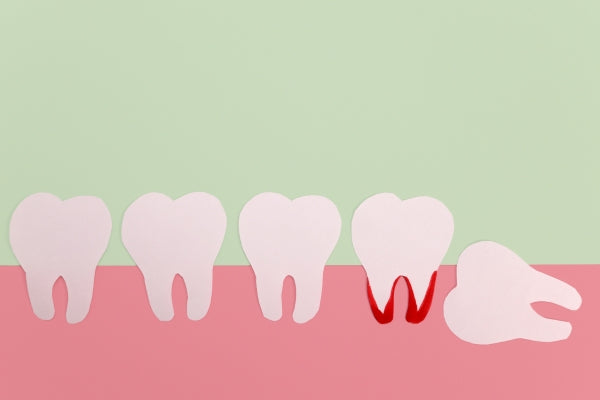
Table of contents
- What Is Orthodontic Tooth Movement?
- Orthodontic Tooth Movement Types
- Tipping
- Uprighting
- Movement of the body
- Both Intrusion and extrusion
- Rotation
- Torquing
- Translation
- Distancing
- The Mesialization Process
- Expansion
- Proclination
- Lingualization
- Movements' Predictability
- The Instruments of the Trade: The Process of Creating Movements
- The Path to a Straighter Smile: Influential Elements
- FAQs
There are several reasons why people smile. On occasion, though, crooked teeth can ruin a flawless smile. In modern orthodontics, there are many ways to achieve a healthier and more upright smile. The first step in this journey is to comprehend the different tooth movements that can be achieved with orthodontic treatment.
What Is Orthodontic Tooth Movement?
Orthodontics involves moving teeth within the jaw. It allows medical professionals to apply mechanical pressure to patients' teeth to obtain the optimal positions, functions, and aesthetics of the teeth.
Orthodontic Tooth Movement Types
The primary objective of orthodontic treatment is to realign teeth in a way that enhances their functioning and beauty. Various tooth motions may be used during orthodontic therapy, such as:
1. Tipping
Tipping is the simplest type of movement that occurs when a tooth's crown is subjected to a single force. When the crown is properly tipped, the root moves minimally in the opposite direction and can only travel in one direction. However, when tipping occurs uncontrollably, the crown tips in the force's direction while the root moves in the opposite direction.
2. Uprighting
Certain teeth may experience mesiodistal tipping of the crowns and opposing tipping of the roots during orthodontic treatment. To tip these roots back into a parallel orientation, the tooth movement must be uprighted.
3. Movement of the body
When the crown and root travel the same distance in the same direction, this is known as bodily movement or translation of teeth. This occurs when the center of resistance (COR) of a tooth is penetrated by the applied force. In a tooth with one root, the COR is located between the third and the half of the root; in a tooth with several roots, it is located between the roots.
4. Both Intrusion and extrusion
When a tooth travels apically (towards the gingiva) along its long axis, it is said to have undergone intrusion. Extrusion, on the other hand, is the movement of a tooth down its long axis in the direction of the occlusal plane.
5. Rotation
Correcting rotated teeth and bringing them into proper alignment is the goal of orthodontic correction. This happens as a result of teeth rotating on their long axes, either labially or lingually/palatally.
6. Torquing
Orthodontists can adjust the axial inclinations of their patient's teeth by torquing the movement of the teeth. The lingual movement of the root characterizes it as reverse tipping as well.
7. Translation
The translation is the process of moving a tooth along the occlusal plane without altering the long axis' orientation.
8. Distancing
A tooth that has been distalized is moved away from the midline along the occlusal plane.
9. The Mesialization Process
A tooth is moved toward the midline along the occlusal plane during mesialization.
10. Expansion
The rear teeth expand when they move outward and away from the midline.
11. Proclination
The labial tip of the anterior teeth is called proclination.
12. Lingualization
Teeth are shifting toward the tongue side of the arch as a result of lingualization.
Movements' Predictability
Some teeth respond better than others to specific orthodontic tooth movements using clear aligners because teeth differ from one another. These are some general recommendations to assist you in selecting instances and setting realistic expectations. fundamental motions
Basic Movements
Particularly well suited for lingual and facial movements are clear aligners. When there is a wide surface to exert force on and nearby retentive surfaces to anchor against, they perform best.
Distal/mesial movements
You might wish to add an engager for additional surface area if the aligner is not making enough contact with the tooth in the clinical crown to "push" the tooth in the right direction.

Most rotations/rotations of lower premolars
When rotating a lower premolar, it is generally easier to rotate a naturally inclined tooth, so make sure there is enough room and consider the tooth root's position. For instance, trying to straighten a mesially-tipped tooth should come before trying to adjust its rotation.
Torquing
When torquing, take note of the crown morphology, especially the length of the clinical crowns, as they can be torqued more readily. Engagers may be helpful for short clinical crowns and crowns without a definite morphology, like bulbous-shaped crowns.
The Instruments of the Trade: The Process of Creating Movements
Braces, clear aligners, and headgear are examples of orthodontic appliances that are used to deliver the forces required for tooth movement. Braces work by bonding brackets to teeth and joining them with wires that gently press against the teeth. A common substitute is clear aligners, which consist of a series of removable, transparent trays that progressively move the teeth into the appropriate positions. Headgear can help with specific movements like molar distalization and give extra control when used in conjunction with other appliances.
The Path to a Straighter Smile: Influential Elements
Any tooth movement's effectiveness is contingent upon several factors:
The severity of Misalignment
The movements required and the length of treatment depends on how intricate the misalignment is.
Individual Tooth Anatomy
The viability of particular motions depends on the length of the roots, the density of the bone, and the general condition of the teeth and jawbone.
Patient's age
Younger patients typically have more malleable bone, which permits quicker tooth movement.
Collaboration with Treatment
Adhering to the appliance recommendations made by the orthodontist
The complex procedure of teeth movement is essential to the treatment of orthodontics. Every kind of movement, including rotation and body motion, helps to achieve the best possible alignment and function of the teeth. Orthodontists can create individualized treatment regimens that provide their patients with stunning, functioning smiles by comprehending these dynamics.
FAQs
1. What kind of movement of teeth is typical during orthodontic treatment?
To achieve ideal alignment and function, orthodontic treatment frequently entails moving the body in such a way that the teeth are positioned parallel to their long axis.
2. Are there any restrictions on the kinds of movements that teeth can make in orthodontics?
Yes, certain movements could be restricted because of things like surrounding tissue health, root form, and bone density. Before arranging a course of treatment, orthodontists carefully consider these issues.
3. How long does it usually take for orthodontic therapy to get teeth to migrate significantly?
The complexity of the case and the kind of tooth movement needed to determine how long orthodontic treatment takes. Treatment can last anywhere from a few months to a few years on average.


